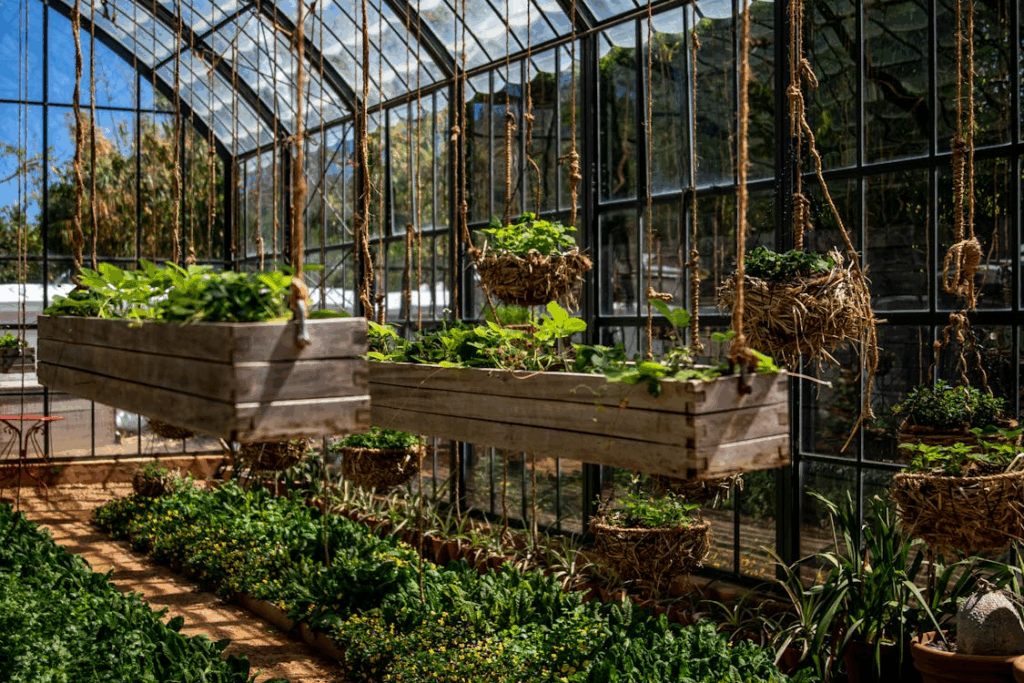Not every outdoor space basks in full sun. That doesn’t mean it can’t support a garden. Shady porches, patios, and balconies can still bloom with life when planted thoughtfully.
Container gardening is particularly efficient in low-light areas, allowing you to create a lush, vibrant look even where direct sunlight is scarce.
Choosing the Right Plants
The key to success in shady spots is selecting plants that thrive in low-light conditions. Ferns, hostas, and caladiums add texture and greenery, while impatiens and begonias provide pops of color. Herbs like mint, parsley, and chives also thrive in partial shade, offering both beauty and culinary usefulness in the kitchen.
Experiment with mixing foliage types, such as broad leaves, delicate fronds, and variegated patterns, to create visual interest. Shade-loving plants often have rich colors and unique forms that make them stand out even without flowers.
For more ideas on growing herbs, see How to Grow Herbs for Everyday Cooking.
Designing with Containers
Containers give you flexibility in arranging plants to maximize light. Lightweight pots can be moved throughout the day to catch shifting sunlight, while tiered plant stands create layers that bring depth to shaded corners. Hanging baskets are another great solution, drawing the eye upward and making the most of vertical space.
Consider container materials, too. Light-colored pots reflect heat and keep soil cooler, while self-watering containers simplify care in tricky environments. Coordinating pot styles can tie your shady garden together into a cohesive design.
Caring for Shade Gardens
Even shade-loving plants have specific needs. Because soil in shady spots dries more slowly, it’s important to avoid overwatering. Check soil moisture before adding water and use well-draining potting mixes to prevent root rot. Fertilize regularly with a balanced formula to keep plants thriving.
Cleaning and rotating pots occasionally also prevents mildew and pests that can thrive in damp conditions. With consistent care, your shaded container garden will remain healthy and vibrant season after season.
To keep your greenery low-maintenance, see Low-Maintenance Plants That Thrive on Porches & Patios.
Playing with Foliage Colors
Shade gardens don’t have to be limited to green. Many shade-loving plants bring vibrant foliage that stands out beautifully in low light. Coleus, for example, offers leaves in shades of burgundy, chartreuse, and pink, while heuchera comes in a range of jewel tones. Mixing colorful foliage with traditional greens adds energy and contrast, giving your shady containers a dynamic look that rivals sun-loving gardens.
Experiment by pairing bold foliage with more subtle plants. A container that combines deep purple coleus with soft green ferns or silvery hostas creates striking visual interest without relying on flowers. This layered approach makes even the dimmest corner feel alive with color and personality.
Creating a Relaxing Atmosphere
Beyond aesthetics, shady container gardens can also enhance the atmosphere of your space. The lush greenery and cool tones naturally create a calming environment, perfect for porches or patios where you want to unwind and relax. Adding elements like a minor water feature or wind chimes complements the soothing effect of the plants.
Incorporating seating nearby allows you to enjoy your shady garden retreat fully. A cozy chair paired with your container arrangements can transform an overlooked corner into your favorite spot to savor coffee, read a book, or unwind. With thoughtful design, shaded areas become not only beautiful but also restorative.
For more design inspiration, see Designing an Outdoor Living Room That Feels Like Indoors.
Summing It Up
Container gardening opens up endless possibilities for shady spaces. By selecting the right plants, arranging them creatively, and caring for them with care, you can transform dim corners into lively, inviting retreats.
Shade doesn’t have to mean dull. When planted thoughtfully, it can be a backdrop for beauty and comfort.




